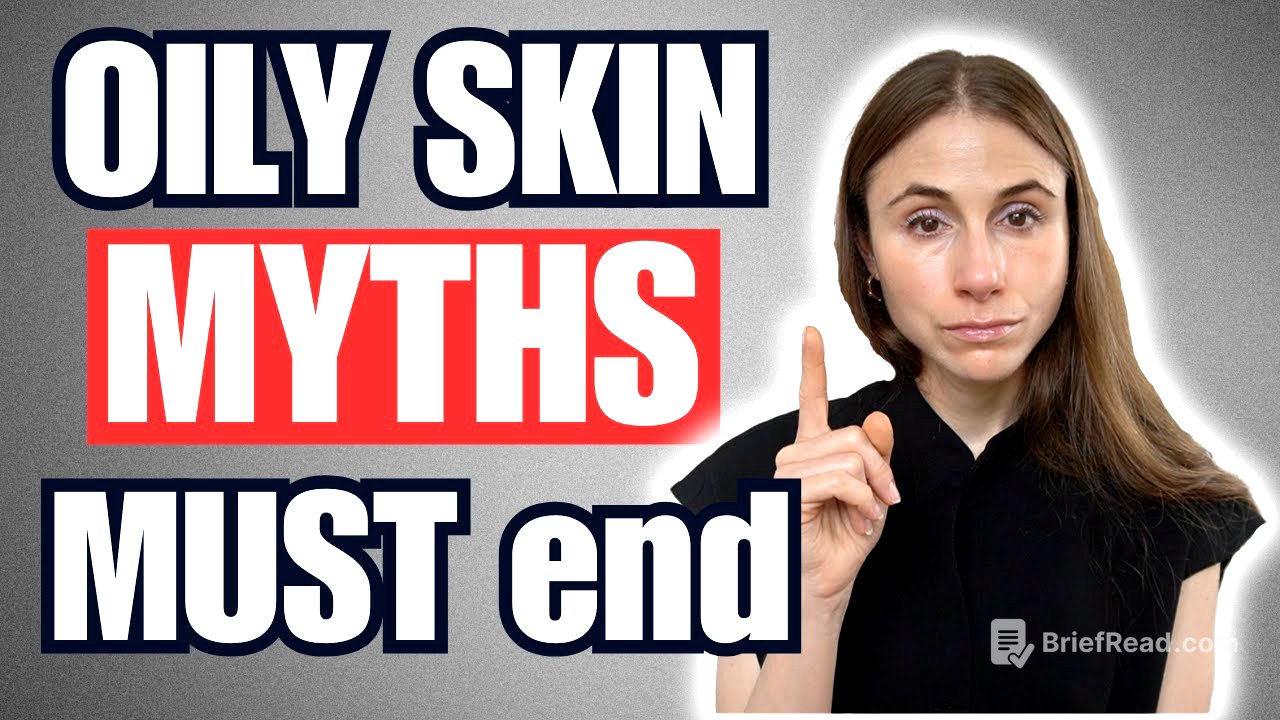TLDR;
This video addresses common myths about oily skin and provides a science-based understanding of sebum production. It clarifies that skincare products have limited direct influence on oil glands and emphasizes the importance of maintaining a healthy skin barrier, even with oily skin. The video also covers practical tips for managing oiliness, including proper cleansing, the use of specific ingredients, and dispelling the myth that washing your face causes more oil production.
- Sebum production is primarily influenced by hormones, not skincare products.
- Drying out oily skin with harsh products is counterproductive; moisturization is still essential.
- Washing your face does not cause increased oil production; it removes inflammatory oxidized sebum.
- Ingredients like salicylic acid, azelaic acid, and clay masks can help manage oiliness and pore clogging.
- Neuromodulators like Botox and certain laser treatments can reduce oiliness by affecting gland signaling or targeting the glands directly.
Introduction: Oily Skin Myths [0:02]
The video addresses the common misconception that skincare products are solely responsible for and the solution to oily skin. It aims to debunk myths surrounding oily skin and provide a better understanding of the biological factors influencing oil production, also known as sebum. The discussion emphasizes the limited direct impact of skincare products on oil production while highlighting how certain products can assist in managing oily skin.
Understanding Sebaceous Glands and Hormonal Influence [0:46]
Sebaceous glands, most abundant on the scalp but also prevalent on the face, particularly in the T-zone, are responsible for oil production. Their activity is primarily governed by hormones, leading to fluctuations in oiliness throughout life, such as during puberty when androgen hormones surge. Hormonal disorders like polycystic ovary syndrome (PCOS) can also cause increased oiliness due to elevated androgen levels in women, alongside symptoms like hirsutism, hair loss, and acne. Stress hormones and cholinergic signaling, influenced by nicotine consumption, can further stimulate oil production and abnormal cell proliferation, leading to clogged pores, blackheads, and whiteheads.
The Myth of Drying Out Oily Skin [2:28]
A common misconception is that oily skin should be dried out, leading to the historical use of harsh astringents and alcohol-based toners. While excessive oil production provides some moisturization, it is often insufficient, and many with oily skin still experience an impaired skin barrier. Therefore, moisturizers are necessary to address barrier issues, reduce water loss, and alleviate inflammation, which can cause redness, dark patches, or loss of skin tone. Sebum itself is not very moisturizing and can become inflammatory when oxidized, contributing to acne and seborrheic dermatitis.
The Role of Cleansing and Sebum Oxidation [4:00]
Bathing does not strip away a magical sebum gold, but over-bathing can lead to dryness and irritation. Sebum left on the skin is not particularly moisturizing and oxidizes, causing inflammation that contributes to acne breakouts, seborrheic dermatitis flare-ups, and hair follicle miniaturization. Regular shampooing to remove sebum is crucial for managing hair loss disorders like androgenetic alopecia.
Skincare Products and Sebum Production [5:01]
Skincare products do not directly cause the sebaceous oil gland to change its behavior, as they cannot activate sebaceous gland receptors. However, some products may seem to increase oiliness due to their heavier textures, which can slow the spread of sebum and cause it to localize, leading to excessive shine. Sunscreens, in particular, are often shiny, but certain ingredients like dimethicone and starches can help absorb excess oil. Mineral sunscreens can be excessively matte for some skin types.
Managing Oiliness: Ingredients and Practices [7:58]
Washing your face does not cause the oil gland to produce more oil; rather, it removes inflammatory oxidized sebum. Washing the face twice a day can benefit those with oily skin. Salicylic acid can improve the appearance of pores and reduce pore clogging, allowing sebum to flow more efficiently. Moisturizing the skin is essential for proper cell differentiation and can reduce pore clogging by maintaining good water content in the outermost layer of the skin.
Additional Tips: Azelaic Acid, Clay Masks, and Sunscreen [11:37]
Azelaic acid can help reduce greasiness and oiliness by promoting efficient skin cell turnover and smoothing the skin surface. Clay masks can absorb excess oil, providing a temporary degreasing effect. It's important not to avoid moisturizers and sunscreens, especially those containing dimethicone and starches, as they help reduce water loss, inflammation, and UV damage, ultimately improving skin health.
The Importance of Moisturizers, Retinoids and Botox [12:57]
Sunscreen is crucial for moisturizing, reducing water loss and inflammation, and protecting against UV rays that oxidize sebum. A lightweight hydrating serum may suffice for nighttime moisturization for oily skin. Topical retinoids normalize skin cell turnover but don't directly influence sebum outflow, while oral retinoids like isotretinoin can shrink oil glands and reduce sebum output, though they require monitoring due to side effects. Botox can reduce oiliness by normalizing signaling to the oil gland, leading to reduced shine and potentially fewer acne breakouts.
Laser Treatments for Oiliness and Conclusion [16:08]
Newer laser treatments like AviClear target the sebaceous oil gland and are used for acne. The video concludes by summarizing the debunked myths and misconceptions about oily skin, encouraging viewers to like the video, share it, and remember to use sunscreen.









